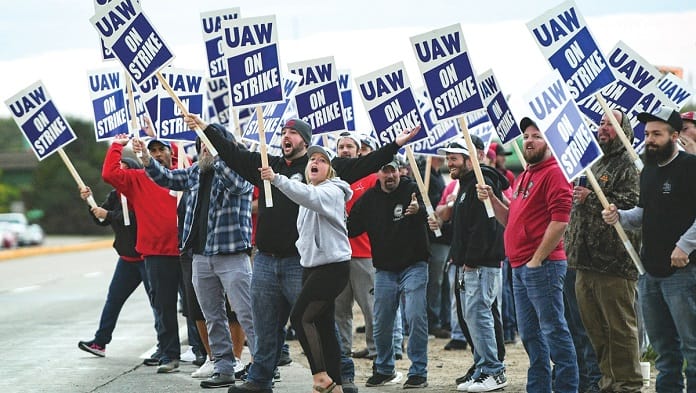American workers were on strike in their tens of thousands in October. Such were the numbers, organisation and picket lines that even the mainstream media dubbed it “Striketober”. More than 185 strikes have taken place in 2021 at about 255 workplaces across the US.
White-collar and blue-collar workers in a range of industries and states walked out against corporate greed, low pay, long hours, two-tier wage rates and job insecurity.
At farming equipment manufacturer John Deere, 10,000 workers across 14 plants in Illinois, Iowa and Kansas are striking for the first time in 35 years, while 1400 workers at Kellogg’s breakfast cereals in four states went on strike after working 16-hour days, seven days a week, for 30 days in a row.
More than 24,000 nurses and allied health staff who work for Kaiser Permanente in California and Oregon are also set to strike for a decent pay rise and to stop a two-tier wage system.
The ongoing working class revolt includes another 1100 coal miners at Warrior Met in Alabama out since April, and a threatened strike by 60,000 film and TV workers in Los Angeles that was called off at the last minute, with union branches set to vote on an improved offer.
A Kellogg’s striker summed up the mood on the picket-lines, “The main issue is our future. Our future is not for sale.”
Essential workers
The strikes have been called the “revenge of the essential worker”. Many of those who were praised as essential when the pandemic began are sick of long hours, low pay, and ever increasing demands from management. Some have received derisory pay offers—such as 1 and 2 per cent for contracts as long as six years at John Deere.
Yet John Deere’s CEO got a 160 per cent pay rise last year to $US16 million. The company is set to make $US5.7 billion in profits. Kaiser Permanente, nominally a not-for-profit, netted $US6.4 billion last year.
Indeed, a recent analysis of wealth in the US found that the billionaire class saw their collective wealth increase by 70 per cent during the pandemic. The $US5 trillion in wealth now held by 745 billionaires is two-thirds more than the combined wealth of half of all US households.
The COVID-19 pandemic has also produced a labour shortage which is boosting workers’ bargaining power, as it has across parts of Australia.
Many American workers have responded by quitting low paid or stressful jobs, since they can easily pick up other work. In August, 4.3 million workers—or nearly 3 per cent of the workforce—resigned from a job. This is the highest figure in the two decades that the Department of Labour has been collecting the data. It follows similar figures from April through July, in what has been dubbed “the Great Resignation”.
Others have decided to stay and fight for better pay and conditions in their existing jobs. An opinion poll in September found 68 per cent of Americans support unions, up notably from a decade ago and the highest since 1965.
Struggling to find workers, many companies such as Walmart, McDonalds and CVS, a pharmacy chain, are raising pay, fuelling the biggest increases in wages in years.
Roots of revolt
The roots of the strike wave also go back to the early years of the Trump presidency.
The West Virginia teachers strike in 2018 against a Republican state government, driven by the rank-and-file in opposition to their union leaders, sparked a strike wave among teachers across the country.
Nearly half a million workers were involved in work stoppages in both 2018 and 2019, the most in more than three decades.
May 2020 also saw the Black Lives Matter revolt over George Floyd’s murder, driven both by rage at police shooting and racialised inequality in the US.
Trump’s mammoth tax cuts for the rich and the attempted repeal of Obama’s limited healthcare plan added fuel to the fire of ongoing class divisions and poverty. But this was only the latest act in four decades of neo-liberal attacks on the working class.
The scale of the strikes is still low by historical standards. Union leaders have continued to undermine strike action and argued to accept concessions to management.
United Auto Workers officials were reportedly “surprised” by the 90 per cent vote against a new contract by John Deere workers, which they had tried to sell as delivering “significant economic gains”.
While the full effects of “Striketober” on American workers’ willingness to fight are yet to be seen, it is a powerful reminder that rolling back US capitalism’s attacks on living standards can’t be left to the Democrats and President Joe Biden.
Workers in both the US and Australia have to take matters into their own hands.
By Tom Orsag






